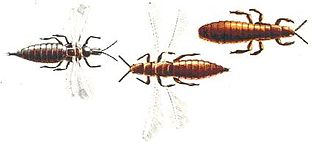
Thrips are minute, slender insects with fringed wings and unique asymmetrical mouthparts. Entomologists have described approximately 7,700 species. They fly only weakly and their feathery wings are unsuitable for conventional flight; instead, thrips exploit an unusual mechanism, clap and fling, to create lift using an unsteady circulation pattern with transient vortices near the wings.
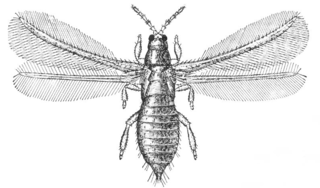
The Thripidae are the most speciose family of thrips, with over 290 genera representing just over two thousand species. They can be distinguished from other thrips by a saw-like ovipositor curving downwards, narrow wings with two veins, and antennae of six to ten antennomeres with stiletto-like forked sense cones on antennal segments III and IV.
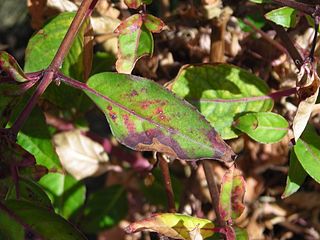
Impatiens necrotic spot orthotospovirus(INSV) is a plant pathogenic virus of the order Bunyavirales. It was originally believed to be another strain of Tomato spotted wilt virus, but genetic investigations revealed them to be separate viruses. It is a negative-strand RNA virus which has a tripartite genome. It is largely spread by the insect vector of the western flower thrips. The virus infects more than 648 species of plants including important horticultural and agricultural species such as fuchsia, tomato, orchids, and lettuce (especially romaine). As the name implies, the main symptom on plants is necrotic spots that appear on the leaves. The INSV virus infects by injecting the RNA the virus contains into the cell which then starts using the cell resources to transcribe what the virus RNA states. Viral infection can often result in the death of the plant. The disease is mainly controlled by the elimination of the western flower thrip vector and by destroying any infected plant material.
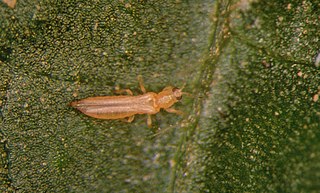
The western flower thrips [Frankliniella occidentalis (Pergande)] is an invasive pest insect in agriculture. This species of thrips is native to the Southwestern United States but has spread to other continents, including Europe, Australia, and South America via transport of infested plant material.

The chilli thrips or yellow tea thrips, Scirtothrips dorsalis Hood, is an extremely successful invasive species of pest-thrips which has expanded rapidly from Asia over the last twenty years, and is gradually achieving a global distribution. It has most recently been reported in St. Vincent (2004) Florida (2005), Texas (2006), and Puerto Rico (2007). It is a pest of economic significance with a broad host range, with prominent pest reports on crops including pepper, eggplant, mango, citrus, strawberry, grapes, cotton, tea, peanuts, blueberry, and roses. Chilli thrips appear to feed preferentially on new growth, and infested plants usually develop characteristic wrinkled leaves, with distinctive brown scarring along the veins of leaves, the buds of flowers, and the calyx of fruit. Feeding damage can reduce the sale value of crops produced, and in sufficient numbers, kill plants already aggravated by environmental stress. This thrips has also been implicated in the transmission of three tospoviruses, but there is some controversy over its efficiency as a vector.
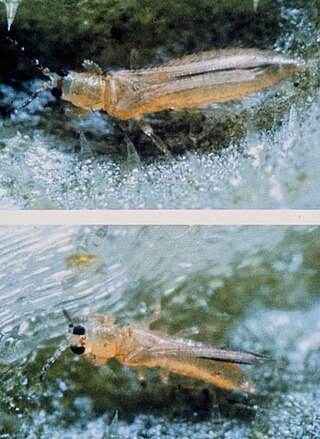
Thrips palmi is an insect from the genus Thrips in the order Thysanoptera. It is known commonly as the melon thrips.
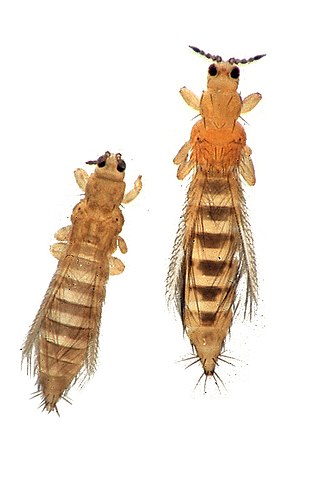
The Thripinae are a subfamily of thrips, insects of the order Thysanoptera. The Thripinae belong to the common thrips family Thripidae and include around 1,400 species in 150 genera. A 2012 molecular phylogeny found that the Thripinae was paraphyletic; further work will be needed to clarify the relationships within the group.

Haplothrips is a genus of thrips in the family Phlaeothripidae. It is found worldwide and contains about 240 extant species.
Dicyphus hesperus is a species of true bug in the family Miridae. It is a generalist predator of other insects and also feeds on plant tissues. It is native to North America and has been used there in biological control of agricultural pests, especially whitefly on tomatoes.

Thrips tabaci is a species of very small insect in the genus Thrips in the order Thysanoptera. It is commonly known as the onion thrips, the potato thrips, the tobacco thrips or the cotton seedling thrips. It is an agricultural pest that can damage crops of onions and other plants, and it can additionally act as a vector for plant viruses.
Frankliniella schultzei, the common blossom thrips or cotton thrips, is a species of thrips in the family Thripidae. It is found in many parts of the world and is an important pest insect in agriculture.
Salpingothrips is a genus of thrips in the family Thripidae. There are at least three described species in Salpingothrips.

Heliothrips haemorrhoidalis is a species of thrips in the family Thripidae. It is most commonly known as the greenhouse thrips, the glasshouse thrip or black tea thrips. This species of thrips was first described in 1833 by Bouché in Berlin, Germany. H. haemorrhoidalis also has many synonyms depending on where they were described from such as: H. adonidum Haliday, H. semiaureus Girault, H. abdominalis Reuter, H. angustior Priesner, H. ceylonicus Schultz, Dinurothrips rufiventris Girault. In New Zealand, H. haemorrhoidalis is one of the four species belonging to the subfamily Panchaetothripinae.
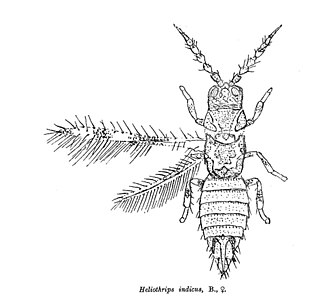
Heliothrips is a genus of thrips in the family Thripidae. There are about 18 described species in Heliothrips.
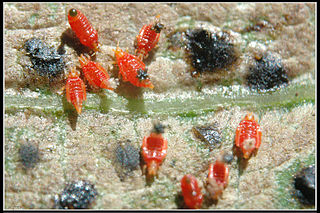
Panchaetothripinae is a subfamily of thrips in the family Thripidae, first described in 1912 by Richard Siddoway Bagnall. There are about 11 genera and more than 50 described species in Panchaetothripinae.
Parthenothrips is a genus of thrips in the family Thripidae. There is one described species in Parthenothrips, P. dracaenae.
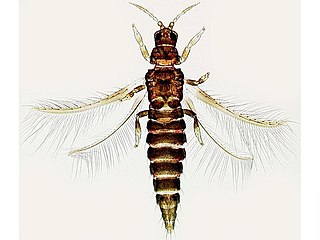
Echinothrips americanus is a species of thrips in the family Thripidae. It is found in North America, Europe, and Asia. E. americanus was first described in 1913 by entomologist A.C. Morgan in Quincy, Florida, where he found the insect on a Veratrum viride plant. Suggested common names include Poinsettia thrips and Impatiens thrips. Since their spread throughout Europe as early as 1995, and subsequently China, E. americanus has been called an "upcoming pest."

Echinothrips is a genus of thrips in the family Thripidae. There are about seven described species in Echinothrips.
Selenothrips is a genus of thrips in the family Thripidae, first described in 1911 by Heinrich Hugo Karny. There are at least two described species in Selenothrips.
Scirtothrips aurantii is a thrips pest of Citrus spp., Mangifera indica, Musa × paradisiaca, Musa acuminata, and Camellia sinensis.












